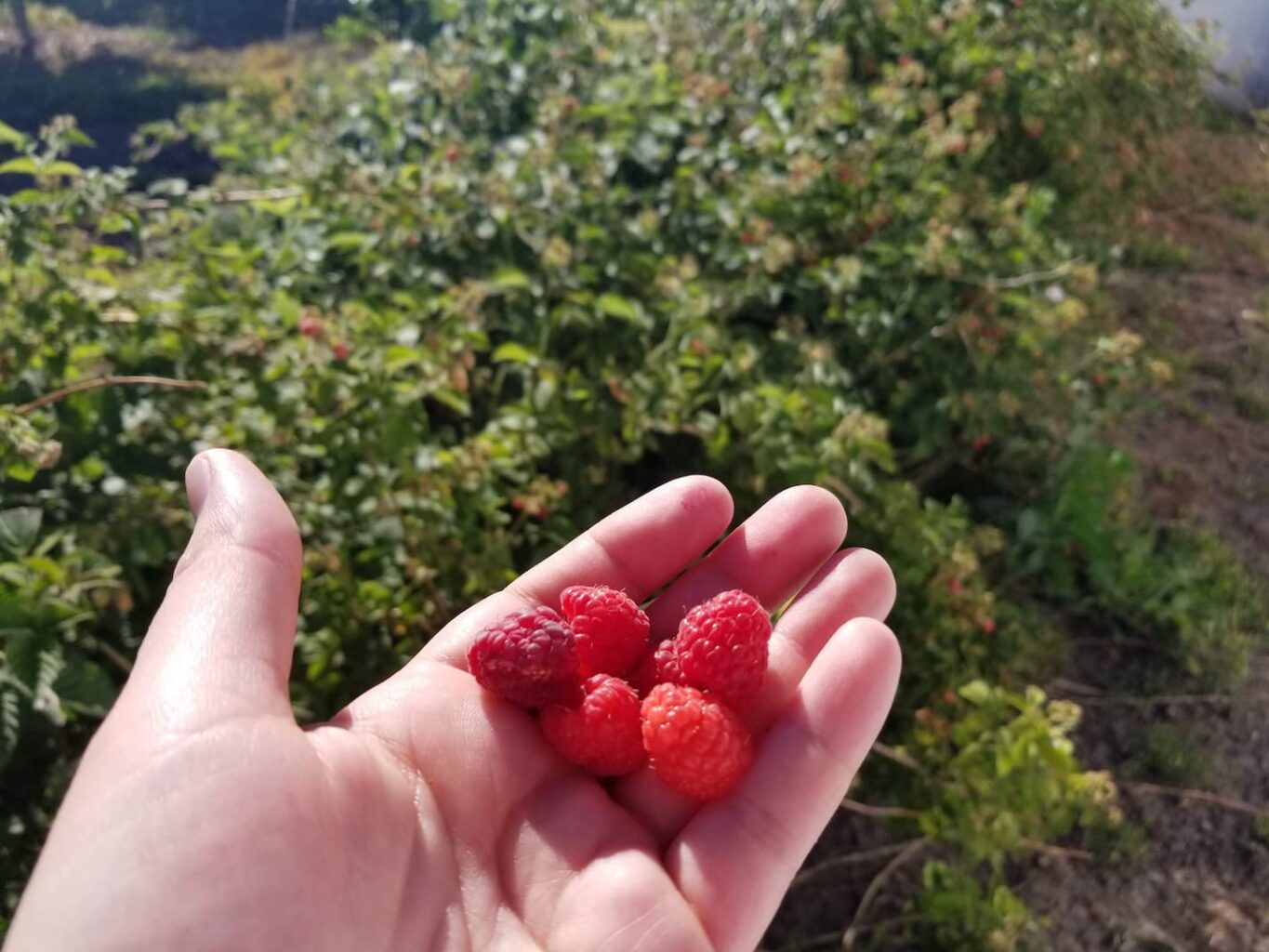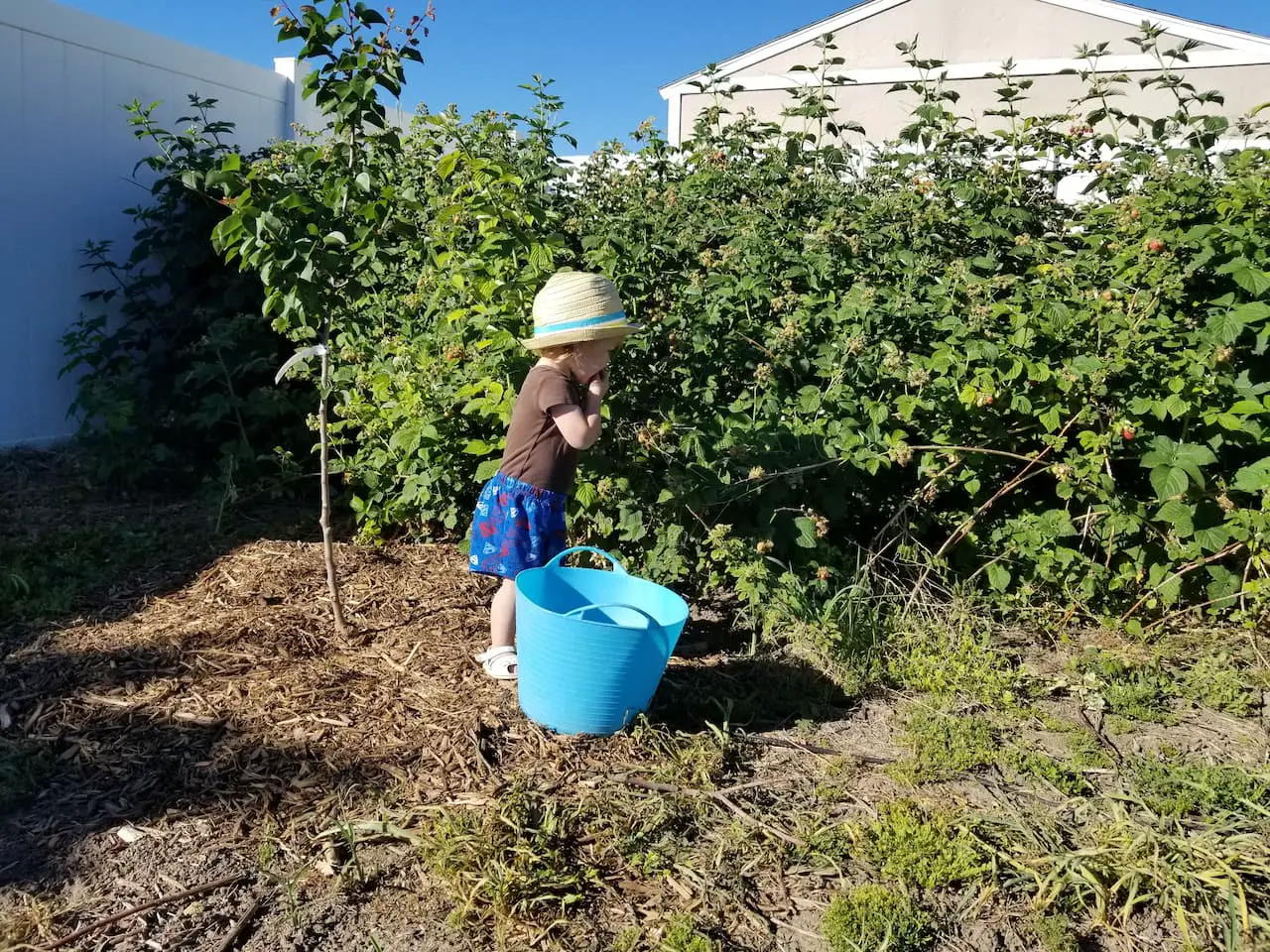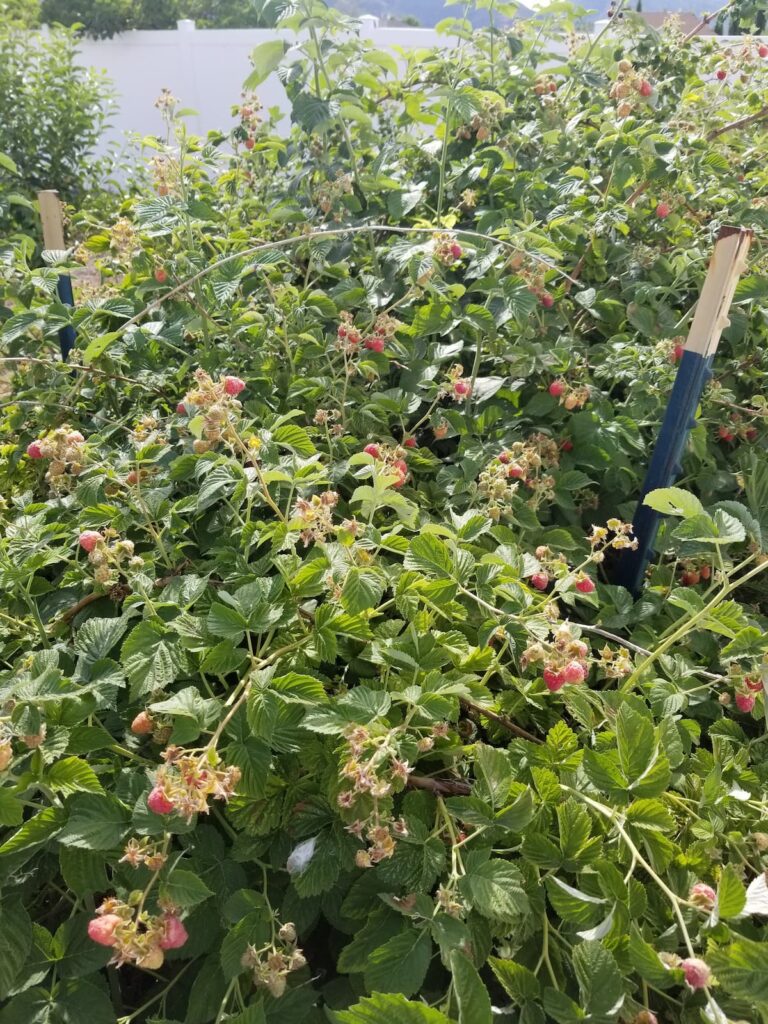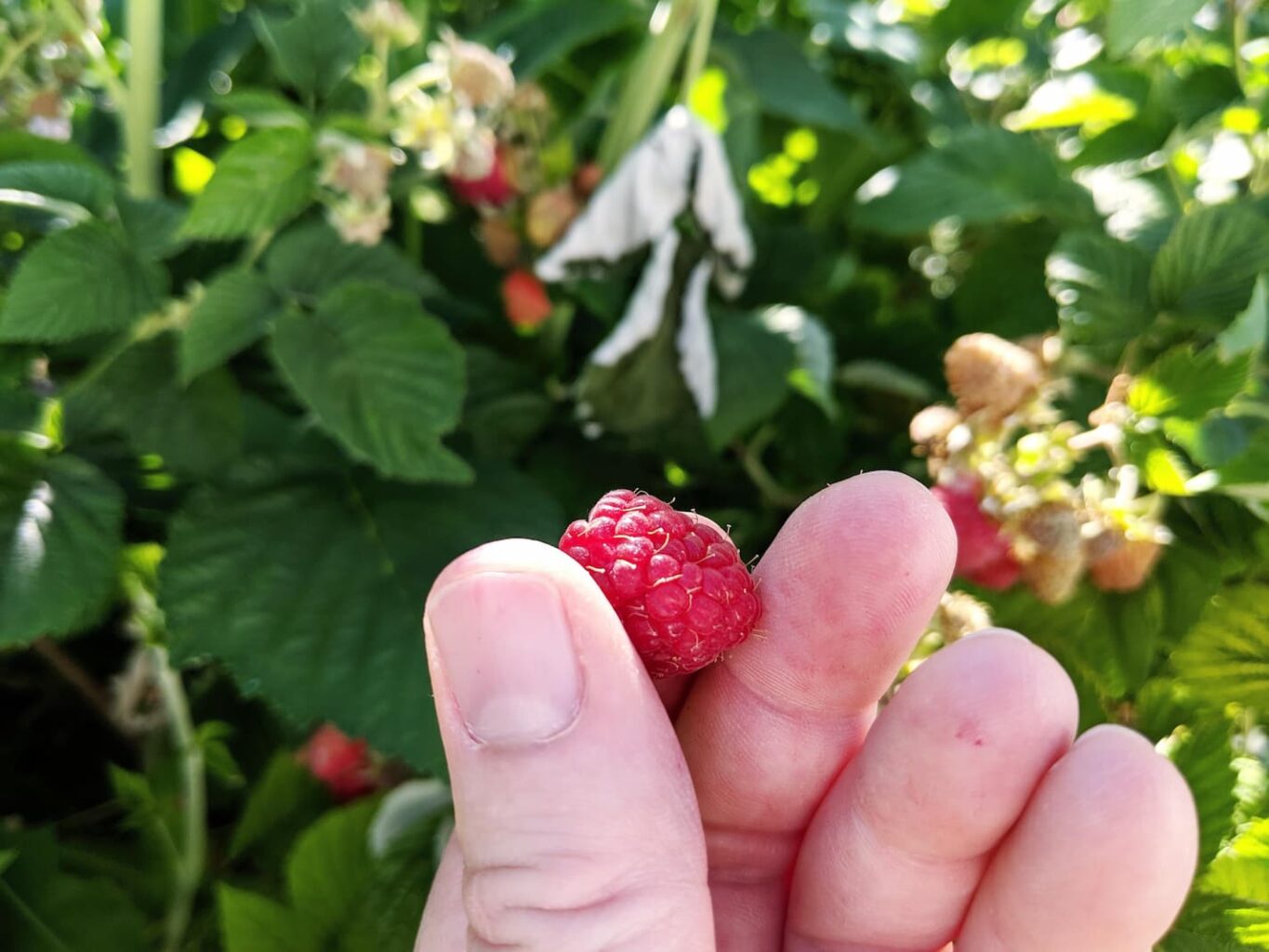When you’re thinking about growing some deliciously sweet and juicy raspberries, it’s important to know where to plant them – and how much sunlight they’ll get. Can raspberry bushes grow in the shade?
Some varieties of raspberry bushes can grow in the shade but they won’t produce as much fruit as those planted in full sun. There are other berries (in the same family as raspberries) that can do better in shade, including gooseberries, currants, and some blackberries. Keep reading for details.
Ready to learn more about raspberries, sunlight, and how to deal with the shade? Let’s dive right on into things.

Can Raspberry Bushes Grow in the Shade?
Raspberry bushes can grow in the shade – but shaded plants won’t produce as much delicious fruit as plants that get full sun. That’s because there is a direct correlation between how much sun raspberry canes get – and how many flowers will grow (and develop into raspberries).
So while they can grow in shaded areas, they won’t grow as well, as fast, or develop as much fruit. Now, how well they grow is going to depend on what kind of shade it is – and how much sun they are still getting.
At our last house, we tried planting blackberries in a shaded part of our front yard. Blackberries and raspberries are botanically very similar – they’re in the same family. Due to the tall trees in our neighbor’s backyard, though, the backyard was too shady to even be considered.
Our blackberry bushes got a few hours of the morning sun but were otherwise shaded during the afternoon. Our poor cane plants grew and looked like pretty vines on their trellis – but they never grew more than a handful of berries.
I did read a literature review study, though, that brought up a great point. The literature reviewed was from the pioneer era – when people were clearing large pieces of land to farm as the United States slowly spread from its first 13 states into the west.
This study found that cleared land, even if it still had towering trees overhead, became prime real estate for bramble plants – specifically blackberries and raspberries. This was due to the fact that, while there was still a canopy of trees overhead, enough sunlight was able to filter down to give the berry plants the sunlight needed to produce a small-to-medium-sized crop of berries.
So in retrospect, maybe I should have tried planting those raspberries under the shade of the neighbor’s trees – it may have been the best shady option available.
What Kind of Sunlight do Raspberries Need? Light Requirements for Raspberry Bushes
Raspberries produce the best fruit in full sunlight, where they get 6-8 hours of sun each day. Full sunlight does not need to be 6-8 consecutive hours; instead, the 6-8 hours could be broken up through the day to prevent sunburned fruit. Raspberries also do better in rich soil that drains well.
So raspberries do need full sunlight. In my experience, though, that sunlight may not need to be 6-8 consecutive hours.
- It could be 2-3 hours in the morning and then 4-5 more hours in the afternoon.
- That full sun could be all in the morning.
- Or the sunlight could be all in the afternoon.
- Or it could be continuous sunlight from morning to afternoon to evening.
In our current backyard homestead, we’ve got a good-sized raspberry patch along our back fence. Okay, so it’s actually flanked by two tall, vinyl fences – meaning that parts of our raspberry bramble get shade at varying times during the day. Because of the alignment, the fences, and how the sun travels, the sunlight is broken up – and there are parts of our patch that do get more sun than others. Even so, that bramble isn’t planted in an area I’d initially thought of as “sunny.”

However, over the course of the day, our raspberry patch is able to get the required 6-8 hours of sunshine. There are even parts of our patch that get more like 8-10 or even 10-12 hours of sunlight each summer day.
Generally, more sun equals healthier and better foliage – and more fruit, too. However, there is such a thing as too much sunlight – even for raspberry bushes.

Can Raspberries Get too much Sun?
Raspberries can get too much sun. They can also get sunburned. Here’s what too much sun looks like for raspberries.
Intense sunlight caused by ultraviolet (UV) radiation, with or without accompanying heat, can cause real problems with brambles… In raspberries, the symptoms are a checkered pattern of white drupelets, an entire section of white drupelets, or the sunny side of the fruit becoming pink and mushy.
Homegrown Berries, page 124
In other words, sunburned raspberry patches will have the following characteristics.
- Sunburned raspberries will have whitened spots or whole areas of white.
- Sunburned raspberry leaves will be wilted or browned.
- Growing raspberries will be smaller, dehydrated, and whiter than fruit that hasn’t been sunburned.
- Too much sun can give the berries a red and white checkered appearance.
Our raspberry patch was planted by the previous owners – and this is why our patch is planted where it is – along the east side of one fence (and the north side of another). That way, the bramble can get some shade during the afternoon – to prevent sunburned fruit.

To avoid sunburned fruit, use these tips.
- Plant your raspberry bushes along an east fence.
- Plant fall-bearing raspberries, rather than June-bearing (this may be an issue at higher elevations and in colder climates).
- Hang a cloth covering over the ripening fruit to prevent or reduce sunburn.
The good news about sunburned fruit is this: it still tastes great. So if you do get a few sunburned drupelets (spots), don’t worry. The berries will still taste fine – they’re just sunburned. If eating whitened fruit doesn’t appeal to you, then make it into a delicious, homemade raspberry jam.
How to Get Full Sun in Shady Areas
Now, if you’ve got a shady area but still want to grow raspberries, you aren’t up a creek without a (raspberry) paddle. You’re just going to have to get creative. Here are some ideas that I’ve tried, found in my research, or learned from others.
- Move your garden to a sunnier spot (if possible).
- Plant your garden or raspberry plants in a moveable pot – then move your garden with the sun.
- Get creative and use reflected light.
Finally, don’t forget about that literature study review I mentioned earlier – the one about how raspberry and blackberry bushes could grow under tall trees even with some shade. Those plants still got enough sun to produce a crop worth mentioning. It just may not be on the same level as a commercial raspberry farm – and that’s okay.
Raspberry and Berry Bushes that Can Grow in the Shade
Based on my research, there are some raspberry and other berry varieties that can grow well in the shade.
- Fall-bearing raspberries – may vary by variety.
- Blackberries can grow with as little as 2-3 hours of direct sunlight per day, but there may be less fruit.
- Gooseberries
- Huckleberries
- Blueberries will tolerate shade, but they produce far fewer berries and become more of a gorgeous ornamental if there’s too much shade.
- Currants
One study I read said that two types of fall-bearing raspberries did manage to grow enough vegetative mass (leaves) to compensate for being grown in an area with only 25% of the recommended light. This study only measured leaves, though, and not fruit. Another shortfall of this study is that it was published in Romania – and the two types of fall-bearing raspberries mentioned aren’t available in the United States.
So if you have your heart set on growing raspberries in the shade, you’ll need to weigh the pros of actual raspberries (but a lot fewer berries) versus having a raspberry cousin, like gooseberries, that’s a different kind of delicious.
Related Questions
Where do raspberries grow best? Raspberries grow best in soil that is well-drained, fertile, and in full sun. Raspberries can grow in zones 3-9, depending on the variety.
How do I grow bigger raspberries? To get bigger raspberries, prune and top your canes. Prune raspberry canes to a maximum of 4-6 canes per foot of a row. Then cut the tops off of the remaining canes. This will reduce the overall quantity of fruit but will result in much larger raspberries.
What kind of soil do raspberries prefer? Raspberries prefer slightly acidic to almost neutral soil (a pH of 5.5-6.5). This helps prevent nutrient deficiencies, especially iron.
Resources
Learning from your own experience is essential, but learning from others is also intelligent. These are the sources used in this article and our research to be more informed as homesteaders.
- “Homegrown Berries.” Google Books, Google, books.google.com/books?hl=en&lr=&id=ggbIBQAAQBAJ&oi=fnd&pg=PP1&dq=raspberry+bushes+sunlight+requirements&ots=uz54x09w2Z&sig=Ox6DqROBDvBfFBx-r2Eiv2Fe-2o#v=onepage&q=shade&f=false.
- “How to Grow Raspberry Plants – Stark Bro’s.” Stark Bro’s Nurseries & Orchards Co., www.starkbros.com/growing-guide/how-to-grow/berry-plants/raspberry-plants/.
- M., Dascalu, et al. Shoot and Leaf Growth Responses to Light Microenvironment and Substrate in Raspberry and Blackberry Cultivars. www.uaiasi.ro/POSCCE/Rubusselect/files/SHOOT AND LEAF GROWTH RESPONSES TO LIGHT.pdf.
- Maughan, Tiffany, and Brent Black. “Raspberry Management for Utah.” Utah State University, Horticulture Extension, Apr. 2015, digitalcommons.usu.edu/cgi/viewcontent.cgi?article=1700&context=extension_curall.
- Pritts, Marvin P. “Raspberries.” Taylor & Francis, www.tandfonline.com/doi/abs/10.1300/J065v04n03_02?journalCode=wzsv20.
- Pritts, Marvin P., et al. “Winter Raspberry Production in Greenhouses in: HortTechnology Volume 9 Issue 1 (1999).” HortTechnology, American Society for Horticultural Science, 12 Dec. 2018, journals.ashs.org/horttech/view/journals/horttech/9/1/article-p13.xml.
- Smith, David M., and P. Mark S. Ashton. Yale University School of Forestry and Environmental Studies, 1993, pdfs.semanticscholar.org/c4e7/30f6234fe2fb80c8cd19b1c4fb1d0a3aa1f2.pdf.
- Thomson, Bob, and Jim Tabor. The New Victory Garden. Little, Brown, 1987.
- Yao, Shengrui, and Carl J. Rosen. “Primocane-Fruiting Raspberry Production in High Tunnels in a Cold Region of the Upper Midwestern United States in: HortTechnology Volume 21 Issue 4 (2011).” HortTechnology, American Society for Horticultural Science, 12 Dec. 2018, journals.ashs.org/horttech/view/journals/horttech/21/4/article-p429.xml.
- “Yard and Garden.” Raspberries, Utah State University Horticulture Extension. extension.usu.edu/yardandgarden/fruits/raspberries.